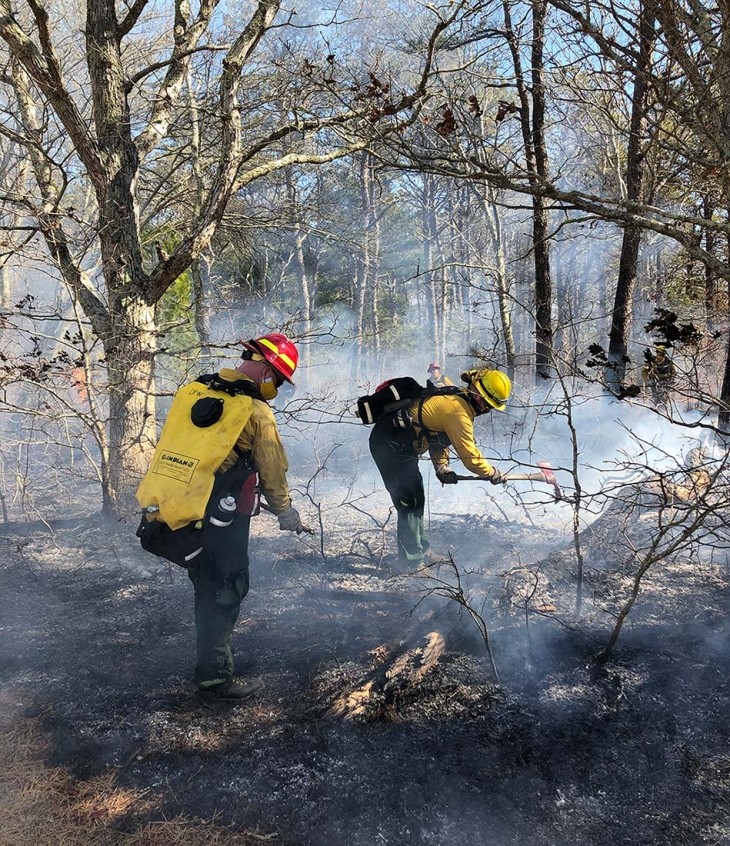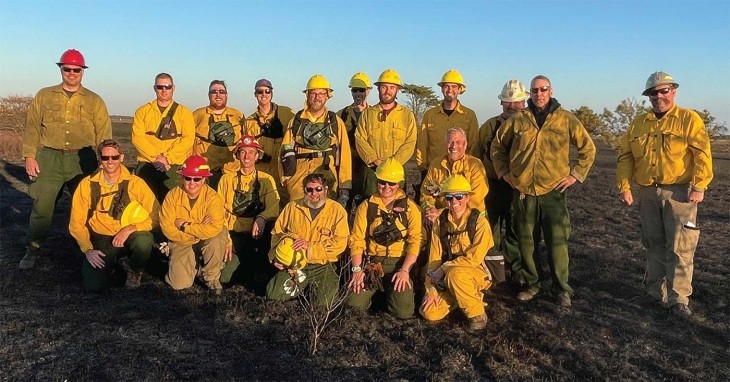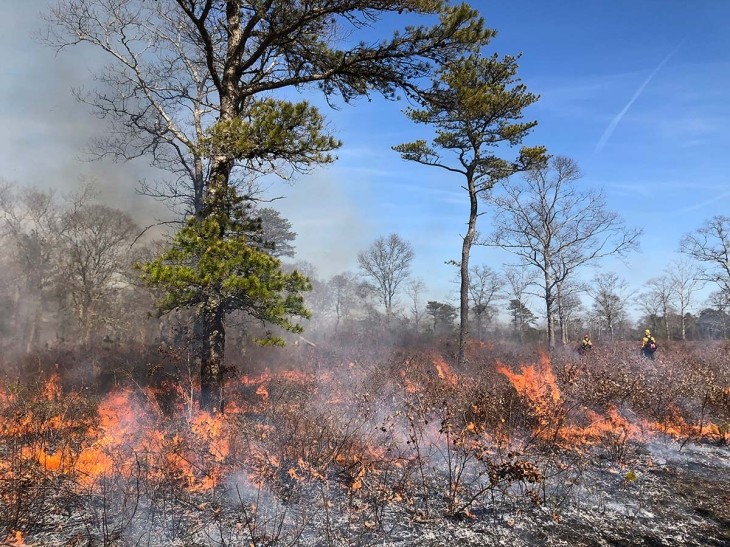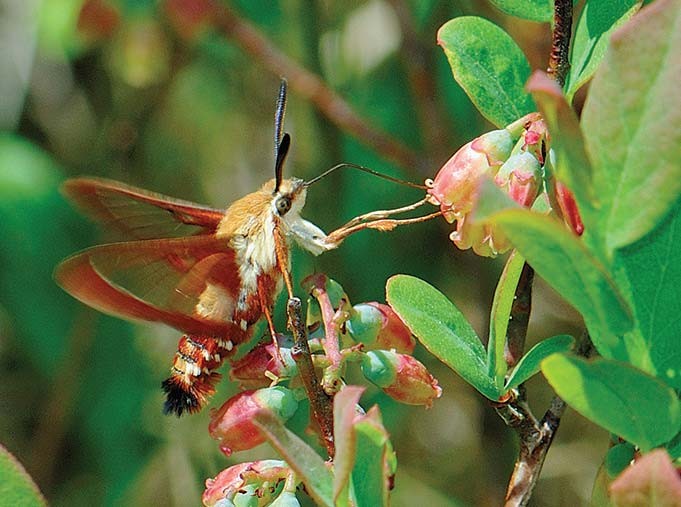
Last year was a record-setting fire season out West, and national news stories about forests and fire were often tragic. However, Caren Caljouw, the prescribed fire program manager for the Massachusetts Division of Fisheries and Wildlife (MassWildlife), has also noticed increasing interest by conservation partners in using prescribed fire in combination with other management techniques that replicate fire as an ecological process under very controlled conditions. Prescribed fires are implemented to achieve specific stewardship goals and to promote healthy functioning ecosystems.
“Last year gave us an opportunity to reach out and explain [the benefits of prescribed fire] more effectively given what was happening out West,” she said. “Although our ecosystems are different, the East Coast is also on the cusp of interesting challenges related to climate change.”
Historically, naturally occurring fires and fires set by indigenous peoples burned through the pine and oak barrens of Cape Cod, allowing fire-dependent plants to reproduce and support animal life in the ecosystem. The arrival of European settlers, changes in land uses including deforestation and agricultural practices, reforestation, and fire suppression over time have led to many overstocked forests that are more susceptible to forest pests and invasive species.
The Pine and Oak Barrens
Since the 1700s, Massachusetts has lost up to 90 percent of its original pine and oak barrens. These barrens naturally formed on xeric, deep sandy soils of southeastern Massachusetts and the outer Cape and islands, the Connecticut River Valley, and as smaller occurrences along outwash sandy areas, deltas, and truncated terraces of inland river systems. They are a subset of a globally declining Atlantic Coastal pine barren ecosystem that extends from New Jersey into southern Maine. It is estimated that Massachusetts has less than 160,000 acres of pitch pine and oak barrens remaining. Still, the barrens of southeastern Massachusetts, stretching from Plymouth to outer Cape Cod and the islands are some of the largest remaining barrens in the northeastern United States, second only to the New Jersey Pine Barrens. Of the almost 75,000 acres that remain on the Cape, many sections are fragmented and cannot support the full spectrum of plants and wildlife that rely on these unique ecosystems.
Pitch pine (Pinus rigida) and several species of oak trees, including black oak (Quercus velutina), scarlet oak (Quercus coccinea), and white oak (Quercus alba), are the dominant trees in the barrens. They grow in dry environments and are highly adapted to survive in nutrient-poor soil, and to regenerate after fire. Some cones of pitch pine are serotinous, which means a percentage of cones stay closed until the heat of a passing fire triggers the cone to open. The thick resin on the cone protects the seeds inside; the heat from fire melts the resin, opening the cones and releasing the seeds. Following a fire, long-dormant buds of a pitch pine can sprout from the trunk. Pitch pine and tree oaks also have thick, plate-like bark that helps them survive the flames of a passing fire.
Scrub oak (Quercus ilicifolia) and its close relative dwarf chestnut oak (Quercus prinoides) are common shrubs in the barrens. Shorter than its other oak relatives, scrub oak rarely exceeds 15 feet in height and has leathery, irregular, spiny leaves. Scrub oak may form dense thickets in open barrens or exist in small gaps beneath a canopy of pitch pine and oak. In more crowded forests it competes for space with pitch pine and other trees.
The scrub oak is essential to the pine barren ecosystem; its leaves are a food source for moths and butterflies, and the acorns provide an essential source of food and fat source for deer, black bear, wild turkeys, and ruffed grouse. Lowbush blueberry is also an important shrub characterizing barrens.
The dry, sandy conditions of the Cape and frequent drought contribute to the fire-prone nature of the pine barrens. Beneath the trees lies a highly specialized understory. Well-managed stands will have open understories of lowbush blueberry, scrub oak, and scattered forbs and grasses. But due to a lack of fire and other management, it’s common to see a dense layer of more shade-tolerant species such as white pine growing in the understory. As these trees continue to grow, they create ladder fuels reaching into the highly flammable and densely stocked pitch pine and oak canopy.
Because fire has been suppressed for so long, a naturally occurring wildfire in Cape Cod’s pine barrens can be dangerous and destructive. Managers from MassWildlife, DCR Bureau of Forest Fire Control, the National Park Service, U.S. Fish & Wildlife Service, Joint Base Cape Cod, town fire departments, and Cape Cod–based land trusts are working to employ mechanical treatments, such as thinning and brush cleaning, alongside burns to bring fire back to the pitch pine and oak barrens and woodlands safely and effectively.
Fire as a Solution
“Fire is our only tool to advance the ecological conditions we want. Pure and simple,” said Tim Simmons. “If you’re going to do something dangerous, it better be worth your while.”
Simmons has worn many hats in the New England prescribed fire community, from land trust work on Martha’s Vineyard to managing New England’s fire program for The Nature Conservancy. For Simmons, who is now retired, the ecologoical goal is to employ fire in all the places on the Cape that need it.
Simmons said many of these areas are now overstocked with pitch pine, leading to dense undergrowth and a large amount of tinder. This makes these areas susceptible to burning quickly – which isn’t safe – and more vulnerable to southern pine beetle, a pest native to the southeastern United States that is moving north, where it is invasive. The beetle attacks pine species and can quickly flatten a pine barren. Currently, winters on the Cape are generally cold enough to kill the beetle, but that protection could quickly disappear in a warming climate.
A history of land use, development, and fire suppression contributes to the current fragmentation of the landscape. However, there’s hope that reintroducing fire will continue to improve the resiliency of these ecosystems.
Caren Caljouw’s first experience with fire came in the 1980s when she was working with The Nature Conservancy as a stewardship manager. She initiated prescribed burns for TNC on Martha’s Vineyard and other key sites in Massachusetts. Since then, she’s worked in various capacities to manage habitat restoration and fire projects across the Northeast from Virginia to Massachusetts. She describes the Mashpee Pine Barrens on Cape Cod and other barrens MassWildlife manages as biodiversity hotspots that may look empty or “barren” but are incredibly diverse.
“These areas support many wildlife resources, including lots of rare and uncommon species – because these sites are flat and vulnerable to development, they are often found in close proximity to residential and industrial development, which poses a unique challenge for restoration and management,” said Caljouw. This is a common experience on the Cape: unique species and swaths of development coexist within a few miles’ radius.
The Mashpee Pine Barrens includes conservation lands owned and managed by MassWildlife, the Town of Mashpee, the Mashpee Wampanoag Tribe, the U.S. Fish & Wildlife Service, and private conservation organizations such as the Orenda Wildlife Trust.
“Managing pine barrens at the landscape scale requires collaboration, partnership, continued outreach, and funding. Partners have been successful because of this collaboration and sharing of resources and skills,” said Caljouw. “Supporting land management on other key tracts in public and private ownership and developing creative strategies to get our work done is critical.”
In 2018, the town of Mashpee received a habitat grant from the state to conduct a prescribed burn and to improve wildlife habitat at the pine barrens. The town completed that burn in collaboration with Northeast Forest and Fire Management, LLC, a skilled private fire management company. Prior to that, this same company helped the Mashpee Wampanoag Tribe jumpstart their fire management program on tribal lands with funding from U.S. Fish & Wildlife Service’s Partners for Wildlife Program.
Prescribed fire partners continue to evaluate and conduct mechanical treatments to reduce fuels, such as thinning trees, mowing tall brush, and maintaining firebreaks with the long-term goal of reintroducing periodic fire as a management tool within the wildland urban interface. So far, the results have been promising.
Another goal for prescribed fire within the Mashpee pine barrens is to enhance habitat for the New England cottontail rabbit, the region’s only native rabbit. This species currently occupies only one-fifth of its historic range and needs shrublands and young forest conditions for food and cover; the pine barrens are one of the few locations where they can thrive in New England.
“We work to maintain safe, healthful, and resilient natural communities on conservation lands with prescribed fire in combination with mechanical treatments,” explained Caljouw. “At the same time, we urge private landowners to reach out to DCR Bureau of Fire Control and local fire departments to learn about programs like Firewise, USA which can help them reduce fire danger in their wooded backyards and make areas safer for firefighters.”

The History of Burning
Fire has historically coexisted with the Cape Cod landscape and was once employed by several tribes within the Wampanoag Nation to manage woodlands, grasslands, cedar swamps, and cranberry bogs.
Durwood Vanderhoop, a grantsman/planner for the Wampanoag Tribe of Gay Head (Aquinnah) on Martha’s Vineyard, remembers that when he was a child the forests of Aquinnah were so open that he could see right through them to the beach. “The elders always talked about how you could walk through the forest wherever you wanted to go – it was much more open 100 years ago,” he said. Since then, tall shrubs, catbrier, and invasive species such as bamboo, honeysuckle, barberry, multiflora rose, and wineberry have moved in, and their spread seems to have accelerated in the past decade.
The Wampanoag Nation land once included all of southeastern Massachusetts and eastern Rhode Island and was home to 67 distinct tribes. European settlers were not in favor of indigenous fire practices. As settlers colonized these areas, the forests were cut down, tilled, or grazed, and as many farming practices were abandoned, forest composition shifted and many became overstocked. Today, many of these forests remain dense and in need of fire or active management to restore them.
The Aquinnah Wampanoag tribe has lived on the island of Noepe, known today as Martha’s Vineyard, for more than 10,000 years. Much of modern fire management mimics the techniques historically employed by the Wampanoag peoples and other tribes.
Tribes burned according to the seasons, often clearing the understory between burns to prevent a large fuel buildup, which kept fires from growing out of control. The subsequent gap in fire management has led to an increased fuel load in parts of New England and across the West, explained Simmons. “We don’t even know what the natural fire regime is in our area because we cut down all the forests,” he said.
The Aquinnah tribe is currently working on a climate adaptation plan that prioritizes practices that are less dependent on fossil fuels. Vanderhoop said that in the future they would love to use more fire to both reconnect with traditional ways and to help with new threats such as ticks. “I would like to encourage practices that are more community oriented and hopefully more ecologically friendly.”
Pine barrens support an array of flora and fauna, including species not found in other ecosystems. The Massachusetts pine barrens are home to many rare and declining plants and animals (more than 40 species), a host of birds (including the whip-poor-will, a state-listed species of special concern), reptiles (including the eastern hognose snake, a species of special concern), and various moths, butterflies, and other invertebrates listed in the state as endangered, threatened, or of special concern (including the endangered Persius duskywing and barrens tiger beetle).
A Future with Fire
Climate change and human pressure could affect how and when fire is best applied in the Cape Cod pine and oak barrens. Seasonal temperature fluctuations and more days between rain events have shifted the optimal time of fire employment. Managers cautiously burn at different times of year depending on their goals for ecological management, fuel reduction, and safety.
Simmons said they can’t burn like they used to – today there are more risks when burning, such as dense forests and greater forest fragmentation, which means more potential for fire to jump to developed areas.
As development increases on the Cape, so does the potential for pushback against burning and the associated smoke. But Simmons and Caljouw said that, so far, negative reactions aren’t common. Managers notify residents well before the first spark and work to minimize smoke during burning operations and beyond with careful prescription planning, understanding of fuels, fire behavior, and weather patterns. The continued outreach within the community with the help of local fire departments is critical. “Prescribed fire is an amazing and effective tool to restore natural communities,” said Caljouw. “But our work can’t happen unless we work closely with partners and air quality regulators, and get the messaging out there.”



